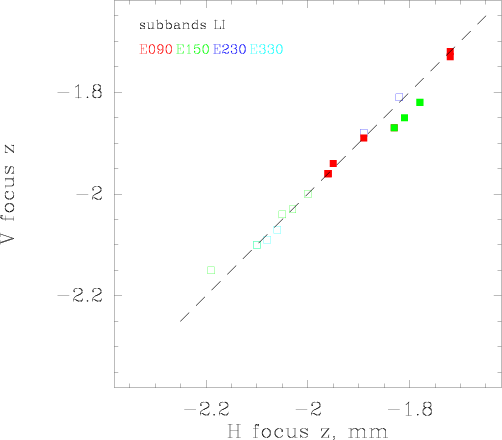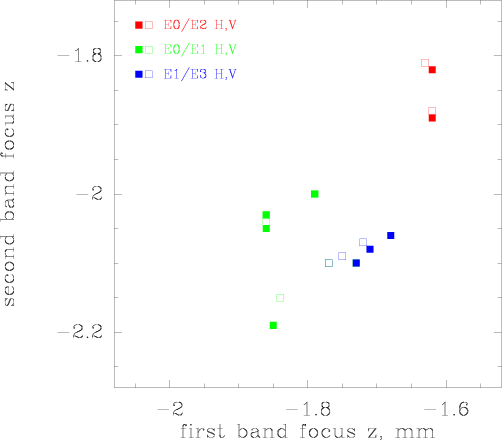![]() under construction
under construction ![]()
- by Juan Penalver, Hans Ungerechts, Helmut Wiesemeyer, Albrecht Sievers, Gabriel Paubert, Walter Brunswig, Clemens Thum, Carsten Kramer
- and Melanie Krips, Sascha Trippe, Dirk Muders, Albert Greve, Karl Schuster
The following presentation is an excerpt from the report to the SAC: status30m-emir.pdf
Nasmyth Offsets
The Nasmyth offsets were determined to be -39.0"/+5.5" for the left beam and +51.0"/+5.5" for the right beam. The left beam is used for most EMIR setups, i.e. for single band E0 or E2 observations, and for dual band E0/E2 and E0/E1 observations. The right beam is used for E1, E3, E1/E3. At present, the observer has to set the Nasmyth offsets in PaKo. They are not yet set automatically when switching the EMIR setup.
Alignment

The above figure shows the alignment between the four EMIR bands and between the two polarisations of each band. The overall alignment is better than 1 arcsec.
Foci

The above figure shows the focus between different polarisations of the same band. There are no significant differences between these foci.

This figure shows the focus between different bands. The largest deviation is about 0.3 mm, similar to the situation with the ABCD receivers. For dual band observations, the telescope should be focussed to the high frequency band.
Telescope Efficiencies
Freq
HPBW
Feff
Beff
Aeff
S/TA*
Comments
GHz
arcsec
%
%
%
Jy/K
86
29
95
81
63
5.9
145
16
93
62
57
6.4
330
7
89
32
29
12.0
The main beam and aperture efficiencies, and the beam widths, were derived from Mars observations at about 43 deg Elevations, i.e. near the maximum of the gain elevation curve on March, 4th, 2009.
Continuum backends
At present, only the central 1GHz of each 4GHz chunk are being used for continuum detection. Broad band 4GHz wide continuum detectors are in preparation.
Spectrometers
During commissioning, we used the 4MHz filterbank and the two auto correlator backends WILMA and VESPA, partly in parallel. A variety of VESPA setups were checked, covering the range of resolutions between 3kHz and 1.25MHz and a wide range of bandwidths. VESPA parallel mode was also checked. However, it is not possible to check all possible setups. The 1MHz filterbank has not yet been commissioned.
Observing modes
The following switching modes were re-commissioned: position switching (onoff), wobbler switching, and frequency switching. Beam switching was checked using the continuum backends. The on-the-fly mapping mode was re-commissioned, in combination with position switching and with frequency switching.
EMIR setups
Band Edges
Commissioning observations
